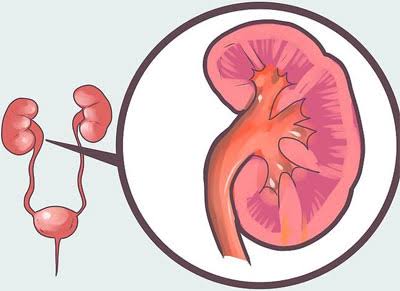Many people may not be familiar with the phrase “nephrotic syndrome,” which refers to a condition that affects the kidneys and can lead to many health problems. We will examine the definition, phases, causes, risk factors, and indications and symptoms of nephrotic syndrome in this beginner’s guide.
We will also go into great length on the significance of investigations and differential diagnosis, as well as how specific dietary decisions can aid in the management of this condition.

The Meaning of Nephrotic Syndrome
Low blood protein levels and elevated urine protein levels are two hallmarks of the kidney disease known as nephrotic syndrome. Many health issues arise from this imbalance in protein levels. Damage to the kidney’s nephrons, which are in charge of removing waste and extra fluid from the circulation, is usually the cause of the condition.
The Stages of Nephrotic Syndrome
Depending on how severe the illness is, there are many phases of nephrotic syndrome. Healthcare practitioners can choose the best course of action and management techniques with the aid of these phases. The phases consist of:
1. Minimal Change Disease (MCD): Often observed in youngsters, MCD is the mildest form of nephrotic syndrome. Under a microscope, the kidneys could seem normal, and the cause is not always obvious.
2. Focal Segmental Glomerulosclerosis (FSGS): This stage is characterized by the scarring of certain glomeruli, the kidney’s filtering units. Forms of this illness can worsen over time.
3. Membranous Nephropathy: The glomeruli’s filtering membranes thicken and inflame during this stage. In adults, it is a frequent cause of nephrotic syndrome.
4. Membranoproliferative Glomerulonephritis (MPGN): This condition might impair the glomeruli’s capacity to filter due to their thickness and swelling.
5. Diabetic Nephropathy: This stage, which is frequently linked to diabetes, is characterized by kidney damage brought on by persistently high blood sugar. The result could be nephrotic syndrome.
Knowing the stages of nephrotic syndrome is essential since it influences treatment decisions and indicates the prognosis for the patient.
The Causes of Nephrotic Syndrome
Nephrotic syndrome may be the consequence of several underlying factors. Among the typical ones are:
1. Primary Causes: As previously noted, these are illnesses that directly impact the kidneys, such as minimal change disease, FSGS, and membranous nephropathy.
2. Secondary Causes: Diabetes, lupus, and amyloidosis are among the illnesses that might result in nephrotic syndrome. Kidney damage is a result of the underlying disease in these circumstances.
3. Diseases: By inflaming the kidneys and causing damage, certain diseases, such as HIV, malaria, and hepatitis B and C, can cause nephrotic syndrome.
4. Medication: A number of pharmaceuticals, including antibiotics and nonsteroidal anti-inflammatory drugs (NSAIDs), can negatively impact the kidneys and possibly result in nephrotic syndrome.
The Risk Factors of Nephrotic Syndrome
Early detection and prevention of nephrotic syndrome depend on an understanding of the risk factors linked to the condition. Typical risk factors include the following:
1. Age: Adults are more likely to acquire nephrotic syndrome as a consequence of other medical disorders, whereas children are more prone to minimal change disease.
2. Gender: Nephrotic syndrome is more common in men than in women.
3. Infections: HIV, malaria, and hepatitis B or C infections in the past can raise the risk of nephrotic syndrome.
4. Family History: Your risk may be increased if kidney illness or nephrotic syndrome run in your family.
5. Usage of Specific Medications: Extended use of drugs known to be harmful to the kidneys may increase the risk.
6. Chronic Illnesses: Nephrotic syndrome is more likely to occur in people who have long-term medical illnesses such as diabetes, lupus, or amyloidosis.
People and medical professionals can monitor kidney health more closely if they are aware of these risk factors.
The Signs and Symptoms of Nephrotic Syndrome
Early diagnosis and treatment of nephrotic syndrome depend on the ability to recognize its symptoms. Typical signs and symptoms include of:
1. Swelling (Edema): One of the most prevalent symptoms of nephrotic syndrome is swelling, especially in the legs, ankles, and feet. This happens as a result of the body holding onto extra fluid.
2. Foamy Urine: The appearance of foamy or frothy urine can be caused by an excess of protein in the urine.
3. Weariness: Weakness and weariness can result from anemia, which is frequently linked to nephrotic syndrome.
4. Loss of Appetite: A decrease in appetite may occur in certain people.
5. Weight Gain: Nephrotic syndrome patients may have rapid weight gain as a result of fluid retention.
6. Hyperlipidemia: People with nephrotic syndrome frequently have elevated blood cholesterol levels.
7. Hypertension: Kidney impairment can lead to high blood pressure, which exacerbates the illness.
Investigations for Nephrotic Syndrome
Many tests are carried out in order to confirm the diagnosis of nephrotic syndrome and identify its underlying cause. These could consist of:
1. Urine Tests: The presence of blood cells and other anomalies can be detected under a microscope, and a 24-hour urine collection can be used to evaluate protein excretion.
2. Blood Tests: Blood tests can reveal information about kidney function by measuring blood levels of proteins, lipids, and creatinine.
3. Kidney Biopsy: To study a small sample of kidney tissue under a microscope, a kidney biopsy may be required in some circumstances.
4. Imaging Studies: Ultrasound and CT scans are two imaging modalities that can be used to see the kidneys and find any structural abnormalities.
5. Immunological Testing: When autoimmune disorders may be a factor in nephrotic syndrome, this testing is crucial.
Decisions about the best course of action for treatment and management must be guided by thorough and timely investigations.
Differential Diagnosis of Nephrotic Syndrome
The technique of differentiating one ailment from another that presents with similar symptoms is known as differential diagnosis. Nephrotic syndrome requires the exclusion of a number of other renal disorders and diseases. Nephrotic syndrome can be mistaken for the following conditions:
1. Chronic Kidney Disease (CKD): Proteinuria and edema are two signs of CKD that can resemble those of nephrotic syndrome. CKD is characterized by a progressive loss of kidney function over time. It is crucial to distinguish between the two for effective management.
2. Acute Kidney Injury (AKI): AKI is characterized by an abrupt loss of renal function and may also include edema and proteinuria. Test results and medical history aid in the distinction between the two.
3. Nephritic Syndrome: Unlike nephrotic syndrome, nephritic syndrome is characterized by elevated blood pressure and blood in the urine. Numerous renal disorders may potentially be the cause.
4. Glomerulonephritis: The fourth condition is glomerulonephritis, an inflammation of the glomeruli that can mimic nephrotic syndrome symptoms. Hematuria, or blood in the urine, is a common side effect, nevertheless.
5. Systemic Lupus Erythematosus (SLE): Nephrotic syndrome-like symptoms can be brought on by lupus, which can affect the kidneys among other organs. Immunological testing is often required for a proper diagnosis.
6. Heart Failure: Peripheral edema brought on by advanced heart failure can be confused with the edema associated with nephrotic syndrome. Making the distinction between the two necessitates a thorough assessment.
Nephrotic Syndrome: Foods to Improve and Avoid
An essential component of controlling nephrotic syndrome is adequate diet. Although a “nephrotic syndrome diet” per se does not exist, certain symptoms can be mitigated and consequences can be decreased with appropriate food choices. Here is some dietary advice:
Foods to Improve Nephrotic Syndrome:
1. Low-Sodium Foods: Cutting back on sodium can help control hypertension and edema. Choose fresh produce whenever possible; stay away from processed and salty foods.
2. Protein Management: To find out how much protein is appropriate for your situation, speak with a dietitian or healthcare professional. Fish, poultry, and lean meats are good sources of high-quality protein.
3. Healthy Fats: To help control high cholesterol, include foods high in healthy fats in your diet, such as avocados, almonds, and olive oil.
4. Fluid Control: If you have severe edema, you may need to restrict your intake of fluids. Advice regarding the proper daily fluid limit can be obtained from your healthcare provider.
Foods to Avoid with Nephrotic Syndrome:
1. High-Sodium Foods: It is best to minimize or stay away from processed and quick foods, canned soups, and salty snacks.
2. High-Protein Diet: Eating too much protein might cause renal strain. Follow your doctor’s recommendations about the amount of protein you should consume.
3. Foods High in Potassium: People who have kidney issues may need to watch how much potassium they eat. Foods high in potassium include potatoes, bananas, and oranges.
4. High-Phosphorus Foods: People with kidney disease may experience bone difficulties as a result of an excess of phosphorus. Steer clear of processed foods and carbonated drinks that have additional phosphates.
5. Excessive Sugar: Diabetes, a common underlying cause of nephrotic syndrome, can be made worse by a high sugar diet. Limit beverages and foods high in sugar.
Interactive Approach and Homeopathy
To treat nephrotic syndrome, some people look into complementary and alternative therapies like homeopathy in addition to traditional medical care. A holistic method of treating illnesses, homeopathy aims to promote the body’s inherent healing powers.
Homeopathic Medicines for Nephrotic Syndrome
1. Terebinthinae: Used to treat kidney inflammation after acute illnesses, scorching discomfort in the kidneys, and trouble urinating. Three to five pills (1C to 6C) three times a day is the suggested dosage.
2. Apis Mellifica: Helps with nephrotic syndrome, which manifests as edema and burning pain when urinating. Three times a day, 10 drops of the 30C tincture are taken in half a glass of water.
3. Apocynum Cannabinum: A highly successful treatment for renal dropsy and nephrotic syndrome urine issues. Three times a day, 10 drops of tincture are delivered in half a glass of water.
4. Arsenicum Album: Used to treat albuminous urine, anasarca, and ascites associated with nephrotic syndrome. Depending on the situation, three to five pills (3C – 30C, 200C) should be taken three times a day.

Conclusion: Be Kind to your Kidneys!
In conclusion, nephrotic syndrome is a kidney disease with a range of etiology, risk factors, and symptoms. Precise diagnosis and treatment are essential, and a thorough comprehension of the ailment can empower people to make knowledgeable decisions regarding their medical care.
Although homeopathy is a viable choice for many individuals, it is advisable to exercise caution and seek guidance from a healthcare provider.
Nephrotic syndrome is an illness that can be managed with a mix of medical treatments and lifestyle changes, which can help the affected individuals live longer and with a higher quality of life.
Reach out to us for a Consultation
For any queries, reach out to us at contact@homeopathic.ai
This blog is for information purposes. It’s crucial to note that while homeopathy is a centuries-old practice with many adherents worldwide, always consult a qualified homeopath or medical professional before initiating any treatment.





